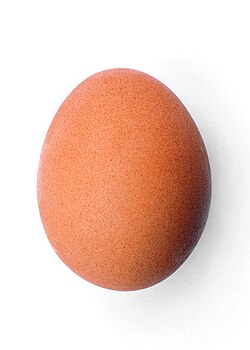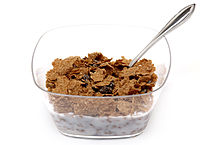Healthy eating habits/Optimising Iron intake and Energy for Women

Do you often feel tired, lethargic, or run down? Is it hard to concentrate? Are you experiencing shortness of breath? You may be suffering from iron-deficiency, a condition that affects about one in five women of reproductive age. [1]Along with getting enough iron, to give you energy for everyday living and stay healthy, it is important to eat a healthy, well balanced diet [2]. On this page you will find some practical and easy ways to meet your daily iron needs and increase your energy levels.
What is Iron deficiency
[edit | edit source]Iron deficiency is the state of having iron depleted stores, that is your body does not have enough iron. It is the most common and widespread nutritional disorder in the world.
Symptoms - how you feel when you have low iron in your body - includes feeling tired, feeling out of breath and not being able to concentrate. [1]
High risk groups
[edit | edit source]Females
[edit | edit source]
Iron deficiency is the most common nutrient deficiency in women. Women during their childbearing years need more iron than men as women lose blood each month through menstruating. [3]
Athletes
[edit | edit source]Physically active women, especially those who engage in endurance activities such as running, or high intensity team sports such as netball, are prone to iron deficiency. High iron loses through menstruation, in combination with the high demand on the muscle protein myoglobin, can cause iron deficiency in physically active women. [3]
Vegetarians
[edit | edit source]Getting enough iron can be a problem even for meat eater, and those who do not eat meat must pay special attention to their iron intake. The iron in plant based foods is called non-haem iron and isn't absorbed as well as haem iron, which is found in animal products.[3] (See section 5)
The role of iron in the body
[edit | edit source]Oxygen transport
[edit | edit source]Red blood cells contain haemoglobin, which is a protein that transports oxygen in the blood to tissues all around the body, including your brain. Iron is a major component of haemoglobin. If we don’t have sufficient iron stores to make up the haemoglobin, we wont be able to enough oxygen to our tissues, and this is why we start to become fatigued. [4]
Muscle
[edit | edit source]Myoglobin, has a very similar role to haemoglobin, however, instead of binding an transporting oxygen in the body, it is the oxygen carrying protein in our muscles. If your Iron stores are low, there is a decreased ability to bind and transport oxygen around your muscles, causing your muscles to fatigue faster, therefore you can't train as hard or be able to perform as well. [4]
Immune system
[edit | edit source]You need appropriate levels of iron to strengthen your immune system. If you are not consuming enough iron you become more susceptible to getting sick and run down.[4]
For a more detailed explanation on the role of iron in the body, you can look at The role of haemoglobin and myoglobin
How much Iron do I need?
[edit | edit source]Recommended Daily Intake[1]
- Women aged 19–50 years 18 mg
- Pregnant women 27 mg
- Lactating women 9 mg
Types of Iron: Haem Vs Non Haem
[edit | edit source]


Haem is the iron-holding part of the haemoglobin and myoglobin proteins. Iron absorption depends on the dietary source it comes from.
Iron occurs in two forms in foods.
Haem Iron
[edit | edit source]Haem iron is only found in foods derived from the flesh of animals. This includes red meat, poultry and fish.
About 25% of haem iron is absorbed. [4]
Top Haem food sources per 100g [5]
| Food | Iron per 100g |
|---|---|
| Oysters | 28mg |
| Liver/ Offal | 23mg |
| Beef/ Lamb | 3.7mg |
| Shrimp/ Prawns | 3.1mg |
| Tuna | 1mg |
Non Haem Iron
[edit | edit source]Non haem iron is found in foods that come from plants and animals. Plant based food sources that are high in iron include green leafy vegetables (spinach, kale, broccoli) iron fortified cereals, nuts, legumes and egg. Only about 17% of non haem iron is absorbed.[4]
Top Non-Haem food sources per 100g [5]
| Food | Iron per 100g |
|---|---|
| Pumpkin seeds | 10mg |
| Cashews | 5mg |
| Dark chocolate | 4mg |
| Spinach | 3.5mg |
| Tofu | 2.7mg |
More food sources of Haem and Non Haem Iron
Iron rich Snack ideas
[edit | edit source]

If you are feeling tired and low in energy, try to snack on iron rich foods throughout the day to maintain your energy levels and increase your iron intake.
Here are some quick and easy snack ideas: [6]
- Dried fruit mix (particularly apricot and raisins)
- Trail mix (mixture of nuts and seeds)
- Wholemeal crackers with liver pâté
- Hummus dip with carrots and celery
Vitamin C and Iron
[edit | edit source]There are many factors that can affect the absorption of iron. Some nutrients can aid the absorption of iron and some nutrients can actually hinder it. Vitamin C helps aid the absorption of iron. [4]
Vitamin C food sources
[edit | edit source]Vitamin C is found in Fruits and Vegetables. Citrus fruits, and red and green vegetables contain high amounts of Vitamin C. Examples of high sources of Vitamin C include oranges, carrots, capsicum, strawberries, broccoli, kiwi fruit and brussel sprouts.[4]
Click here for an extensive list of foods containing Vitamin C Food List

Ways to add Vitamin C to your meals
[edit | edit source]- Add some fruit (strawberries, oranges, peaches) to your iron-fortified cereal a breakfast;
- Add lots of green vegetables into your meat stir fry (broccoli, asparagus, capsicum, spinach, green beans);
- Try making a tuna salad with spinach leaves and cherry tomatos;
- When having a salad or sandwich try to incorporate a meat (chicken, lamb, tuna), or alternatively add a hard boiled egg or some beans or legumes and add some carrot and red or yellow capsicum. [7]
Here are some more great ideas with Recipes
Get checked out today!
[edit | edit source]If you think you might be Iron deficient, all that is required is a blood test which you can get at your local GP.
Or for expert nutrition and dietary advice contact an Accredited Practising Dietitian (APD) in your local area by visiting ‘Find an APD’ at www.daa.asn.au or call 1800 812 942.
Reference List
[edit | edit source]- ↑ a b c Better Health Channel (2012). Iron Deficiency - Adults. Retrieved from http://www.betterhealth.vic.gov.au/bhcv2/bhcarticles.nsf/pages/Iron_deficiency_adults
- ↑ NHMRC. (2013). Eat For Health: Australian Dietary Guidelines. Summary. Retrieved from http://www.nhmrc.gov.au/_files_nhmrc/publications/attachments/n55a_australian_dietary_guidelines_summary_131014.pdf
- ↑ a b c Brown, J. E., Isaacs, J. S., Krinke, B., Lechtenberg, E., Murtaugh, M. A., Sharbaugh, C., Splett, P. L., Stang, J., & Woolridge, N. H. (2011). (2011). Nutrition through the life cycle (4th ed.). Belmont, CA: Wadsworth, Cengage Learning.
- ↑ a b c d e f g Whitney, E., Rolfes, SR, Crowe, T., Cameron-Smith, D. & Walsh, A. (2011). Understanding Nutrition: Australia and New Zealand Edition. South Melbourne, Australia: Cengage Learning Australia.
- ↑ a b Healthaliciousness (2013). Top 10 foods highest in Iron. Retrieved from http://www.healthaliciousness.com/articles/food-sources-of-iron.php Invalid
<ref>tag; name "iron content" defined multiple times with different content - ↑ Nutrition Australia (2013). Recipes. Retrieved from http://www.nutritionaustralia.org/national/recipes
- ↑ Dieticians Association of Australia (2009). Are you getting enough Iron? Retrieved from http://web.archive.org/web/20120320132810/http://www.healthyweightweek.com.au/files/Iron%20Brochure%20FINAL.pdf
